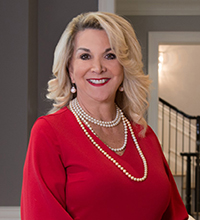Email is a staple of office productivity, and one of the easiest ways for real estate agents to engage their spheres of influence. But it’s just as easy to alienate clients and teams with marketing emails that miss the mark and fail to deliver value in exchange for your readers’ time. How can you reconcile these two conflicting truths, and deliver regular content that is a benefit to your clients, colleagues, and prospects?
It takes vision, strategy, and diligence, but it can be done. Here are actionable recommendations from two leading agents who have found a way to make email marketing work wonders.
Create a database — or several

Daniel Gale Sotheby’s International Realty
Skylar Champion, Global Real Estate Advisor with Briggs Freeman Sotheby’s International Realty in Dallas, Texas, maintains a database of her complete network, featuring over 25,000 names and addresses — but she’s quick to qualify that she would only rarely send an email to everyone at the same time.
“Targeting who I send emails to depending on what the content is has made all the difference in the effectiveness of each campaign,” she says. “I have a database of California agents that I may send an email to regarding a specific listing, or I might send an email to a small number of clients in a specific area that may be interested in a certain type of home. I sometimes send an email to my entire sphere regarding an upcoming event or market data.” She adds, “I only email open house information if someone requests it.”
To enhance email effectiveness, she advises agents to start making a database, cataloging each address in their network with specific tags so that they can quickly pull together a list of potential buyers, top agents, brokerages, and any other contacts they might need to reach out to.
But ultimately, having multiple streams of email content makes the biggest difference. Nikki Sturges, Global Real Estate Advisor at Daniel Gale Sotheby’s International Realty in Huntington, New York, uses this tactic to streamline her communication. “My advice would be to create a database of your real estate colleagues, your family and friends, and your clients, and then create three templates that offer the reader a concise and thought-provoking summary for everything they need to know about you, your listing, and your market,” she advises.
Depending on the goal of the email, Champion has different lists that she sends emails to as well. This purposefulness has gotten her some great outcomes. “I was able to sell a home directly from one of my emails,” she recalls. “I sent one out about hip neighborhoods and my buyer fell in love with one of the homes on that list. It resulted in a sale.”
Add value with variety, but keep it relevant

Skylar Champion, Global Real Estate Advisor, Briggs Freeman Sotheby’s International Realty
There are certain elements that enable email campaigns to perform better, capturing the attention of their recipients and delivering real meaning to clients and contacts. “Overall, visual elements are the most important aspect of my email marketing, with videos being the most popular items in terms of clicks and shares,” says Sturges.
She identifies three key topics that her correspondences tend to cover:
News that may impact her sphere of influence in their decision to buy or sell properties in the current market. Calls to action regarding any recent or relevant listings, ensuring that her colleagues and buyers are aware of any adjustments in prices. Personal, authentic stories — whether it’s professional tips on handling negotiations, or something interesting in the neighborhood.
Nikki Sturges, Global Real Estate Advisor, Daniel Gale Sotheby’s International Realty
Sturges and Champion abide by the same simple rule—quality over quantity—curating bespoke, meaningful messaging that reaches the right audiences at the right time. “I send both marketing emails for listings, as well as branding emails, which include market stats, holiday e-blasts, business updates, and other important and pertinent information,” says Champion.
“The most important element is creating something of value to be delivered to your audience,” she elaborates. “No one wants to receive emails from you every week about generic information that doesn’t pertain to them.” Champion, therefore, goes to great lengths to think empathetically, and question what information her contacts will genuinely enjoy.
Sturges agrees that tact and consideration are critical. “I have a surprisingly receptive audience, but it starts by my getting permission to email my clients from the outset,” she says.
The medium makes the message

Briggs Freeman Sotheby’s International Realty
Changing audience behaviors and digital platforms are transforming how people connect with campaigns — something that Sturges has kept an eye on. “Email marketing is constantly evolving, and this year I’ve been monitoring the increase of emails being read on a mobile device or tablet. It’s over 60%,” she says. “So my presentation and templates have been adapted to the screen size.”
She has also integrated her email marketing into her client relationship management (CRM) system, which notifies her automatically of who she needs to reach out to, as well as when and why.
This relates to one of the biggest benefits of digital communication for luxury agents: the ability to collect and analyze data, and track campaign success in real time.
How readers respond to your emails can show you how to adjust and tailor them in the future. “I fully understand the power of email marketing due to a recent ask for help I made on behalf of a charitable event,” notes Sturges. “The email became the most shared of the month and I even had clients calling to ask what more they could do.” It’s capabilities like these that enable top agents to differentiate themselves and ensure that email remains a reliable, versatile tool for delivering value to a large and diverse network.
Source: click here














